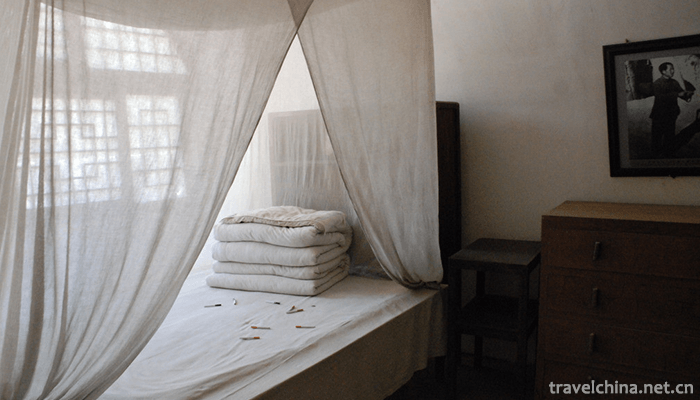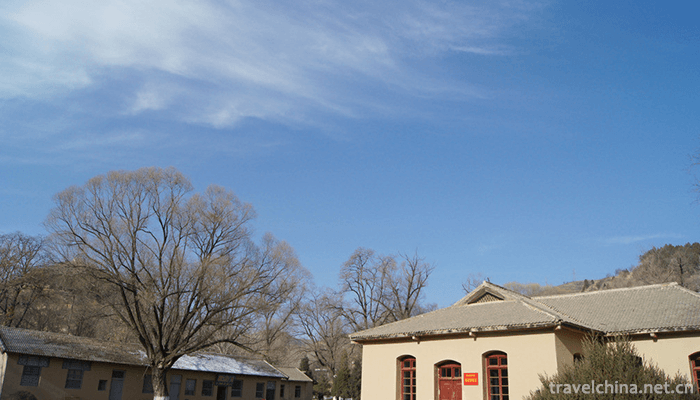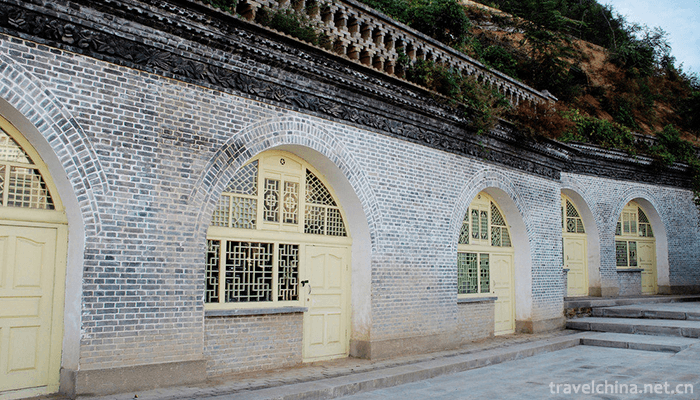The Old Site of Zaoyuan Revolution
The Old Site of Zaoyuan Revolution
Zaoyuan is located 8 kilometers northwest of Yan'an City. It is a garden-like revolutionary memorial. There are many kinds of flowers, plants and trees growing in it. The scenery is beautiful and the environment is quiet. It was originally a landlord's manor. After the Central Committee of the Communist Party stationed in Yan'an, it became the residence of the Ministry of Central Society and was renamed Yanyuan. From 1944 to March 1947, the Secretariat of the Central Committee of the Communist Party of China was relocated here by Yang Jialing. During this period, it led the whole Party to carry out the rectification campaign and the mass production campaign carried out by the military and civilians in the liberated areas, and prepared for the Seventh National Congress of the Communist Party of China.
In December 2016, the old site of Zaoyuan Revolution was listed in the national list of red tourism classic scenic spots.
brief introduction
The old site of Zaoyuan Revolution is the seat of the Secretariat of the Central Committee of the Communist Party of China. It is 8 kilometers northwest of Yan'an City. This was originally a landlord's manor. After the Central Committee of the Communist Party of China was stationed in Yan'an, it was renamed "Yanyuan" as the residence of the Ministry of Central Society. The word "Yanyuan" was written by Kang Sheng on both sides of the stone pillar of the old site. From 1944 to March 1947, the Secretariat of the Central Committee of the Communist Party of China was relocated here by Yang Jialing. During this period of residence, the Secretariat of the CPC Central Committee continued to lead the whole Party to carry out the rectification campaign and the mass production campaign carried out by the military and civilians in the liberated areas, to prepare for the Seventh National Congress of the CPC, to lead the army and civilians of the whole country to the final victory of the War of Resistance Against Japan, and to lead the people of the whole country in a tit-for-for-tat struggle with the die-hards of the Kuomintang for democratic unity and The reactionaries of the Democratic Party made full preparations for the full-scale civil war.
In Zaoyuan, there are old residences of Comrade Mao Zedong, Comrade Zhu De, Comrade Zhou Enlai, Comrade Liu Shaoqi and Comrade Ren Bishi, all of which are of great historical significance. In addition, the jujube garden is a garden-style revolutionary memorial, with beautiful scenery in spring, summer, autumn and winter, a quiet environment, and a variety of flowers, plants and trees growing in it. Every building is indistinguishably decorated with beautiful scenery and charming scenery. In 1996, the torch relay of the 5th National University Games "Century Fire" was held in Zaoyuan to collect the "Revolutionary Fire" torch seeds. It is one of the important bases of revolutionary traditional education in China.
Historical contribution
During his residence, Mao Zedong wrote "Several Questions Concerning Leadership Methods", "Rent Reduction, Production and Support for the Government and the People Movement in Base Areas", "Comments on the Eleventh Plenary Session of the Kuomintang Central Committee and the Third National Political Participation Committee", "Organizing","
"Achieving Economic Work in Two or Three Years", "Learning and Current Situation", "Commenting on Chiang Kai-shek's Speech in the Double Ten Festivals", "The United Front in Cultural Work", "On the United Government", "The Situation and Our Guidelines after the Victory of the War of Resistance Against Japan", "The Last War of the Japanese Crown", "On Chongqing Negotiations", "Establishing a Consolidated Northeast Base Area" and many other guides China. There are 28 important revolutionary articles in Selected Works of Mao Zedong.
Major Events
During this period of residence, the Central Committee has witnessed many important events. In November 1944, Mao Zedong met here with President Roosevelt's personal representative, successor U.S. Ambassador Hurley, and held two days and two nights of talks. He signed five proposals for the establishment of a coalition government from the Communist Party of China to the National Government. In December, he also met with Mr. Bao in his residence, strongly refuting the Kuomintang's three proposals. In August of the following year, he left here for Chongqing to negotiate with Chiang Kai-shek. In 1943, in the mass production campaign of the PLA, Zaoyuan held a civil-military spinning competition. Zhou Enlai and Ren Bishi were both rated as "spinning experts".
In August 1945, Mao Zedong and Zhou Enlai went to Chongqing to negotiate. Liu Shaoqi acted as Chairman of the CPC Central Committee and presided over the central work. On September 15, Liu Shaoqi convened leading comrades Zhu De, Peng Dehuai, Ren Bishi, Chen Yun and Ye Jianying to discuss the Northeast issue. He decided to establish the Northeast Bureau of the CPC Central Committee with Peng Zhen as its secretary, and appointed Peng Zhen, Chen Yun, Gaogang, Zhang Wentian and more than a quarter of the formal and alternate members of the Political Bureau of the CPC Central Committee to lead 20,000 cadres and 100,000 troops into the Northeast. On September 19, Liu Shaoqi and Zhu De, after consulting Chairman Mao Zedong, drafted the inner-party directive on the Strategic Guidelines for North-to-South Defense, which strongly supported the negotiation struggle in Chongqing and played an important role in shortening the front, concentrating troops and developing and consolidating the northeastern base areas.
In February 1947, introduced by Ye Jianying, Liu Shaoqi and Wang Guangmei married here. On September 8, 1944, Mao Zedong attended the memorial meeting of martyrs Zhang Side at the foot of Xishan Mountain in Hougou, Zaoyuan. He wrote an elegy in his own hand: "Salute Comrade Zhang Side who sacrificed for the interests of the people!" He also delivered an important speech on Serving the People. After the withdrawal of the Central Committee of the Communist Party of China from Yan'an in 1947, the Kuomintang army destroyed Yan'an destructively, and the jujube garden was seriously damaged. After 1953, the people's government began to maintain the original appearance one after another.
Introduction to Scenic Spots
Jujube Garden, also known as Yanyuan Garden, has lush trees and green grass. Happiness Canal crosses the garden. The garden center is located in the auditorium of the Secretariat of the Central Committee. Five independent courtyards are located on the hill. They are the old residences of Mao Zedong, Zhu De, Zhou Enlai, Liu Shaoqi, Ren Bishi, Zhang Wentian, Peng Dehuai and other central leaders. Xishan Xixia of Hougou is Mao Zedong's speech platform for "Serving the People" and the old site of the Central Ministry of Social Affairs. Three kilometers to the West are the old site of the Third Bureau of the Central Military Commission, the exhibition hall and the Martyrs'Cemetery of the Third Bureau of the Central Military Commission. In 1953, the old site of the Zaoyuan Revolution began to be restored and opened to the outside world in 1959. On March 4, 1961, the State Council announced that it was the first batch of key national cultural relics protection units. In 1996, it was named one of the hundred demonstration bases of patriotism education by the Central Propaganda Ministry. The old site is now open to the public free of charge.
Soviet-style auditorium
There is a small Soviet-style auditorium in the Zaoyuan Garden. It is surrounded by green grass. In addition to meetings, it is also a restaurant for the Secretary of the Central Committee. There are also dances and movies. Mao Zedong's decision to accept Chiang Kai-shek's invitation to negotiate in Chongqing in 1945 was made at the enlarged meeting of the Political Bureau held here.
Confidential room
Opposite the small auditorium is a house of similar appearance but smaller size. It is an important room. Many important telegrams are sent and received here. In addition, there are management functions of espionage personnel. Some rooms are displayed in their original state. Some rooms are opened up as exhibition rooms. Photos and materials are used to show the development process of our party's aircraft work.
Residential area
Before entering the residence of the leaders, we can see the bronze statues of the five secretaries of the Central Committee (Ren Bishi, Zhou Enlai, Mao Zedong, Liu Shaoqi and Zhu De) striding forward together. The carved bronze statues are vivid and vivid. The weather on that day is fine. The five people's faces are radiant and full of spirits, which shows the joy of the upcoming establishment of a new China.
Happiness canal
Happiness Canal is located on the right side of Zaoyuan Courtyard near the hillside, passing through the middle of the courtyard. The canal is 6 kilometers long and was built in April 1940. It can irrigate more than 80 hectares of land. The canal turned the dry land of Zaoyuanchuan into irrigated land, and the crops were harvested year after year. So the people named it Happy Canal.
Cave dwelling
The caves where the leaders live are much the same as the other two old revolutionary sites, but the cave buildings here are better, probably because they were built by landlords. The caves here are quite complete, that is to say, the five secretaries and several other central leaders have lived in caves, which display precious pictures of themselves or their spouses. The caves in the jujube garden are roughly divided into three layers, scattered throughout the garden. The old site of Zaoyuan has also been renovated, but left a period of Yan'an period of broken brick road for people to hang on, those great men were on such a road to win thousands of miles.
Lecture platform
Another famous scenic spot in Zaoyuan is Chairman Mao's lecture on Serving the People, which was made in memory of martyr Zhang Side. He and his comrades-in-arms dug and burned the charcoal kiln together in a heavy rain, pushed them out at the moment when the kiln was washed down by rainwater, and sacrificed themselves. Chairman Mao wrote a eulogy for Comrade Zhang Side, who sacrificed for the interests of the people, and delivered a speech entitled "Serving the people". Chairman Mao's inscriptions of these five characters can be seen on the wall of the entrance to the South Gate of Zhongnanhai, the seat of the central government.
Tourism information
Ticket Price
Tickets: 0 yuan, free of charge
Traffic hints
Take Bus No.3 in the City
Scenic spot
Hukou Waterfall of the Yellow River-Yangjialing Revolutionary Site-Wuqi Revolutionary Site-Shaanxi-Gansu-Ningxia Border Region Government Auditorium-Liu Zhidan Martyrs Cemetery
Jiulongquan-Nanniwan Revolutionary Site-Laoshan Forest Park-Wanhua Mountain-Wanjiawan Revolutionary Site
Luochuan Loess National Geopark-Huangdi Mausoleum-Qingliangshan-Loess Custom Resort of Luochuan Guzui-Martyr Cemetery of "4.8" Memorial Hall of Yan'an South Cooperative Community-Dugong Temple-Shihong Temple Grottoes-Xie Zichang Mausoleum-Zhongshan Grottoes-Yan'an National Forest Park
The Cemetery of Martyrs in Wazi Street Campaign-Yan'an Revolutionary Memorial Hall-Ansai Museum-the Old Site of Security Revolution-Yan'an News Memorial Hall
Phoenix Hill-Wayaobao Revolutionary Site-Qianfo Temple Grottoes-Fuxian Pagoda-Folk Culture Village-Zaoyuan Revolutionary Site
Luochuan Folklore Museum-Baota Mountain-the Old Site of Luochuan Conference-the Old Site of Lu Xun's Art and Literature-Qin Zhidao
Wangjiaping Revolution Site-Chau Enlai distress site in Huangyan Mountain-Shigong Temple Grottoes-Wanfeng Pagoda-the first oil well in mainland China





-
1.China Railway HighSpeedCRH
China Railway High-Speed (CRH) has two meanings: the technical standard of China High-Speed refers to the passenger dedicated line railway with 250 km/h
Time 2018-11-13 -
2.The Simatai Great Wall
Simatai Great Wall is located in the north of Simatai Village, Gubeikou Town, northern Miyun District, Beijing. It is adjacent to Gubeishui Town. The wall of Simatai Great Wall is built on the steep m
Time 2018-12-10 -
3.The Great Wall Site of Qin Dynasty in Ningxia
The site of the Great Wall of King Zhao of Qin Dynasty was built in the twenty-fifth year of King Zhaoxiang of Qin Dynasty (272 BC). It was built to defend against the invasion of the Huns in the sout
Time 2019-02-07 -
4.Cai Lifo quan
Cai Li Foquan is one of the Nanquan in Chinese traditional boxing. Legend has it that Chen Heng (1806-1875), a native of Jingmei Township, the new capital of Guangdong Province,
Time 2019-04-04 -
5.Hui Heavy Knife Wushu
Heavy knife is the original name of big knife. It is a traditional weapon around Beijing and Tianjin. It has a history of thousands of years in China. The original name of Jinmen
Time 2019-05-04 -
6.Jinghe Opera
Jinghe Opera, a local traditional drama in Lixian County, Hunan Province, is one of the national intangible cultural heritage.
Time 2019-05-08 -
7.Lv Opera
Lv Opera, also known as masqueraded Yangqin and Qinxi Opera, National intangible cultural heritage, one of the eight major Chinese operas, Shandong's most representative local operas, is popular in mo
Time 2019-05-15 -
8.Mongolian Boke
Boke is one of Mongolian traditional sports and recreational activities. People on the grassland call Mongolian wrestling "Boke" (strong, united and lasting meaning of Mongolian). It is the
Time 2019-06-03 -
9.The Lisu Knife and Rod Festival
The Lisu Knife and Rod Festival, which is called "A Tang De" in Lisu language, means "Climbing Dao Festival". It is a traditional festival of Lisu and Yi people living in Lushui Co
Time 2019-06-17 -
10.Custom of mud fish
The custom of filling mud fish is a local traditional handicraft with a long history in Guangdong Province. It combines traditional handicraft weaving and fishing skills. However, even in Doumen, the
Time 2019-08-10 -
11.Suzhou University
Suzhou University is a full-time undergraduate college in Anhui province. It is an applied undergraduate university in Anhui province. Anhui higher education revitalization program "Local applica
Time 2019-11-21 -
12.Leshan secondary industry
In 2019, the industrial added value of Leshan City is 68.028 billion yuan, an increase of 8.8% over the previous year, accounting for 36.5% of the city's GDP, driving economic growth by 4.0 percentage points and contributing 52.8% to economic growth.
Time 2020-12-17